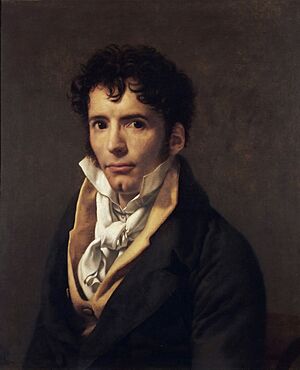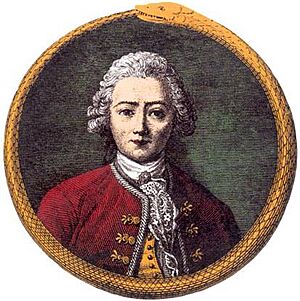Nicolas Chamfort facts for kids
Quick facts for kids
Nicolas Chamfort
|
|
|---|---|
 |
|
| Born | 6 April 1741 Clermont-Ferrand, France
|
| Died | 13 April 1794 (aged 53) Paris, France
|
| Occupation | Playwright, writer |
| Known for | Epigrams and aphorisms |
Nicolas Chamfort (born Sébastien-Roch Nicolas; 1741–1794) was a French writer. He is most famous for his short, clever sayings called epigrams and aphorisms. Chamfort also worked as a secretary for King Louis XVI's sister. Later, he became involved with the Jacobin club during the French Revolution.
Contents
Life of Nicolas Chamfort
Early Life and Education
Nicolas Chamfort was born Sébastien-Roch Nicolas in Clermont-Ferrand, France, on April 6, 1741. There are some different stories about his birth. One record says his father was a grocer named Nicolas. Another record suggests his parents were unknown. Local stories say he was the son of an aristocratic woman and a clergyman. He was then adopted by the grocer.
When he was nine, Chamfort moved to Paris. He received a scholarship to study at the Collège des Grassins. He was a very bright student, though he often seemed to be dreaming. He once famously said, "What I learned I no longer know; the little I still know, I guessed." After finishing his studies, he chose the name Chamfort.
Starting a Writing Career
For a while, Chamfort earned money by teaching and writing small pieces. He was known for his good looks and quick wit. In 1764, he had a successful play called The Young Indian Girl. After this, he wrote many poems, essays, and odes. His writing became well-known in 1769. This was when the Académie française gave him a prize for his work about the famous writer Molière.
Chamfort often relied on the kindness of friends for a place to live. They enjoyed his conversation. In 1770, another play, Le Marchand de Smyrne, brought him more attention. He seemed set for a successful career. However, he became ill. A friend gave him money so he could rest and recover. During this time, he wrote another prize-winning essay about La Fontaine.
Life at Court and Marriage
In 1775, Chamfort met the duchesse de Grammont. Through her, he was introduced to the French royal court. In 1776, his play Mustapha et Zeangir was performed for King Louis XVI and Marie Antoinette. The king then gave him a pension, which was like a regular payment. The Prince de Condé also made him his secretary.
Chamfort did not like the strict rules of court life. He soon left his job with the prince and moved away. He later fell in love and married a woman who worked for the duchesse du Maine. She was 48 years old, smart, and worldly. Sadly, she died within six months of their marriage. Chamfort then lived in Holland for a short time before returning to Paris. In 1781, he was elected to the Académie française, a very important French institution.
In 1784, Chamfort became secretary to the king's sister, Madame Élisabeth. He also received more money from the royal treasury. Even though he often made satirical comments, he made friends at court. He eventually left court life for good after a difficult personal situation. He then lived with a friend, M. de Vaudreuil. There, he met Honoré Mirabeau, a key figure in the French Revolution. They became close friends, and Chamfort even helped Mirabeau write some speeches.
Role in the French Revolution
The start of the French Revolution completely changed Chamfort's life. He strongly supported the republican movement. He used his own money to help spread revolutionary ideas. He became a public speaker and was one of the first people to enter the Bastille prison when it was stormed. Until 1791, he served as secretary of the Jacobin club, a powerful political group. He also wrote for newspapers and helped write an important address to the French people for Talleyrand.
As the Revolution became more extreme under leaders like Marat and Robespierre, Chamfort grew critical. He did not agree with the harshness of the Jacobins. After the fall of the Girondins, another political group, his political involvement ended. However, he could not stop speaking his mind. His sharp comments, even about the new government, led to trouble. He was arrested and sent to the prison des Madelonnettes. After his release, he was threatened with arrest again. He decided that he would rather die than face more imprisonment and restrictions.
Chamfort's Writings
Chamfort's writings include comedies, political articles, literary reviews, and letters. His most famous work is Maximes et Pensées (Maxims and Thoughts). These are short, wise sayings. They are considered some of the most brilliant and thought-provoking sayings of his time, similar to those of La Rochefoucauld.
Chamfort's aphorisms are known for being bold and sometimes critical of society. They show the strong, revolutionary spirit of his era. Writers like Sainte-Beuve compared them to well-made coins that keep their value, and to sharp arrows that "arrive suddenly and still whistle."
Main Works
- Praise of Molière (1769)
- The Fountain of Praise (1774)
- The Merchant of Smythe (comedy)
- Mustapha and Zéangir (tragedy)
Collected Works
- Collected by Pierre Louis GINGUENE, 1795, 4 volumes.
See also
 In Spanish: Nicolas Chamfort para niños
In Spanish: Nicolas Chamfort para niños


